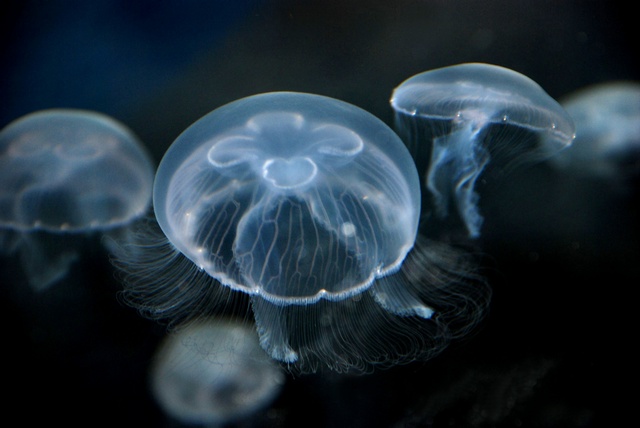Wednesday, February 16, 2011
February 16, 2011 : Aurelia aurita
Aurelia aurita
Aurelia aurita (moon jelly, moon jellyfish, common jellyfish, saucer jelly) is one of a group of more than ten morphologically nearly identical jellyfish species in the genus Aurelia. In general, it is nearly impossible to identify Aurelia medusae without genetic sampling, so most of what follows about Aurelia aurita, could equally be applied to any species of the genus. The medusa is translucent, usually about 25–40 cm in diameter, and can be recognized by its four horseshoe-shaped gonads that are easily seen through the top of the bell. It feeds by collecting medusae, plankton and mollusks with its mucusy bell nematocyst-laden tentacles and bringing the prey into its body for digestion, but is capable of only limited motion; like other jellies it primarily drifts with the current, even when it is swimming.
The cosmopolitan genus Aurelia is found throughout most of the world's oceans, from the tropics to as far north as 70° latitude and as far south as 40°. The species Aurelia aurita, whose distribution has been confirmed by Michael Dawson using genetic analysis, is found along the eastern Atlantic coast of Northern Europe and the western Atlantic coast of North America in New England and Eastern Canada. In general, Aurelia is an inshore genus that can be found in estuaries and harbors. It lives in ocean water temperatures ranging from 6 °C to 31 °C; with optimum temperatures of 9 °C to 19 °C. A. aurita prefers temperate seas with consistent currents. It has been found in waters with salinity as low as 6 parts per thousand.
Aurelia aurita is known to be eaten by a wide variety of predators including the Ocean Sunfish (Mola mola), the Leatherback Sea Turtle (Dermochelys coriacea), the scyphomedusa Phacellophora camtschatica, and a very large hydromedusa (Aequorea victoria). Moon jellies are also fed upon by sea birds, which may be more interested in the amphipods and other small arthropods that frequent the bells of Aurelia, but in any case, birds do some substantial amount of damage to these jellyfish that often are found just at the surface of bays.
Aurelia jellyfish naturally die after living and reproducing for several months. It is probably rare for these moon jellies to live more than about six months in the wild, although specimens cared for in public aquarium exhibits typically live several to many years. In the wild, the warm water at the end of summer combines with exhaustive daily reproduction and lower natural levels of food for tissue repair, leaving these jellyfish more susceptible to bacterial and other disease problems that likely lead to the demise of most individuals. Such problems are responsible for the demise of many smaller species of jellyfish. In 1997, Arai summarized that seasonal reproduction leaves the gonads open to infection and degradation.
Some metazoan parasites attack Aurelia aurita, as well as most other species of jellyfish.
Subscribe to:
Post Comments (Atom)


No comments:
Post a Comment